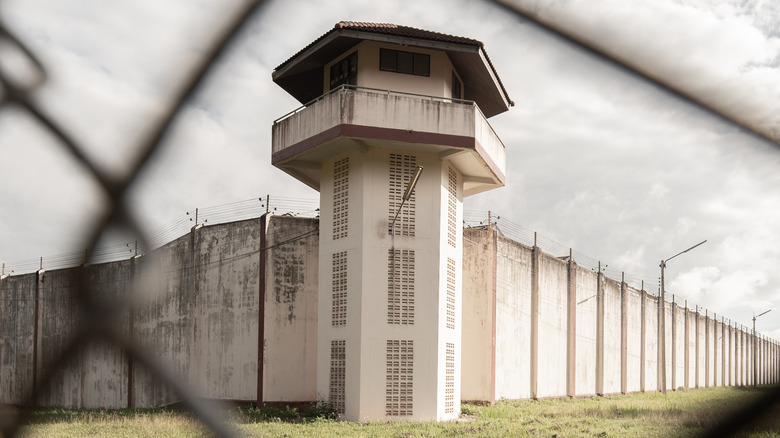Things Monster: The Jeffrey Dahmer Story Got Wrong
The new Netflix show "Monster: The Jeffrey Dahmer Story," which focuses on the nightmarish sprees of the Milwaukee-based murderer, generated a major buzz almost as soon as it was released. The same debates have swirled around the show that face the True Crime genre in general — whether or not putting the antics of a serial killer in the spotlight risks glorifying the gore while skating over the immense suffering of those who died, in the process torturously spinning out the grief experienced by their families.
For all the question marks that hover over its genre, "Monster" at least makes a major effort to get the facts of the Dahmer case right. Given that he butchered 17 young men and feasted on their flesh, his life really was one where truth was stranger than fiction. Not much dramatic license was needed to make a show that was both terrifying and compelling. In the process, rather than lionizing its subject, "Monster" often highlights how much racist and homophobic negligence dogged the Dahmer case, preventing the saving of lives and the pursuit of justice for Dahmer's victims and their families (via Indiewire).
There's no doubt that the Jeffrey Dahmer case will continue to be a topic of ghoulish fascination for a long time yet. However the makers of the show have actually been praised for their levels of accuracy and attention to detail — but inevitably it doesn't get everything right. Below are the ways the show goes slightly astray.
Dahmer didn't drink blood from a bag
The dramatized version of Jeffrey Dahmer's life shows him getting a job in a blood plasma clinic in Milwaukee. While there he furtively gets hold of a bag of blood and sidles up to the roof, where he proceeds to consume it.
This isn't strictly accurate. It's true that after being discharged from the military, where, according to AP, he worked as a Germany-based Army medic between 1979 and 1981, he got a job as a phlebotomist in a plasma clinic. His discharge from the army happened due to accusations of alcohol abuse. After leaving, he got a job in a delicatessen, but was thrown out of the hotel he was lodging in for not paying the rent, as stated by Newsweek. He had stints living with his father and stepmother as well as his aunt, punctuated by trouble with the law; only a week after he moved in with his family, he was arrested for public disorder related to his drinking. Dahmer was fined $60 and given a 10-day jail sentence, which was suspended. It wouldn't be the first time he was arrested on this basis.
When he moved in with his aunt, Dahmer started working in the Milwaukee Blood Plasma Center. Yet surprisingly for a future cannibal, Dahmer did not initially like the taste of blood. Rather than drinking a whole bag of it, he took some from the blood plasma clinic where he worked, trying a vial before spitting it out (via Milwaukee Journal Sentinel).
Christopher Scarver attacked Dahmer first
Jeffrey Dahmer's violent rampage came to an end in 1991, when he was caught after one of his victims alerted the police, having narrowly escaped from Dahmer's apartment, as described by the Tab. He was given 15 consecutive life sentences. His attempt to plead insanity was rejected, and in total he was sentenced to 941 years in prison. Yet he would serve less than three of those years.
Fellow prisoner Christopher Scarver, another convicted murderer, had grown angry with Dahmer's behavior in prison, particuarly, claimed Scarver to the New York Post, his fondness for pretending ketchup was blood and turning prison food into body parts. Dahmer's murder apparently came about because Scarver felt that he was unrepentant about his crimes, something his fellow prisoner claimed he could tell from the serial killer's eyes. However, Scarver later wrote in a blog post that the Post misquoted him. Dahmer's lawyer also contested Scarver's claims, saying that taunting people wasn't his former client's "style."
"Monster" shows Scarver attacking inmate Jesse Anderson before moving on to Dahmer. However, in reality he went for Dahmer first. Although he had initially been isolated from the other prisoners, Dahmer had requested a greater level of interaction, including being able to work and eat meals with the general prison population. He apparently used to taunt them by saying "I bite." When left alone with Anderson and Dahmer while on cleaning duty, Scarver attacked and beat Dahmer to death before turning on Anderson.
Dahmer knew Hughes as early as 1989
Jeffrey Dahmer stated that one of his victims, a man from the deaf community named Tony Hughes, only became known to him the night before he was murdered. This was untrue. Although "Monster" shows them dating over the course of 1991, in reality they had known each other since 1989. According to the Milwaukee Journal Sentinel, a friend of Hughes stated that the pair had been seeing each other for two years before Hughes was abducted. Dahmer had visited her house at least six times in search of him.
According to Esquire, Hughes had become a member of the deaf community when some medication he received as an infant led to a permanent loss of hearing. He also became a mute. Despite these setbacks, his mother reported that he was a happy and confident young man who had modeling aspirations while he was a college student in Madison, Wisconsin. "Monster" shows Hughes and Dahmer forming a relationship where Dahmer displays an unusual degree of tenderness towards the other man.
Yet Hughes was seen alive for the final time in May 1991 at Milwaukee's 219 Club. Dahmer lured him back to his apartment, drugged him, and murdered him, dismembering his body in the process and keeping his skull as a trophy. The discovery of Hughes' skull, along with his vertebrae, meant he was able to be identified by his dental records. He was one of the 11 victims of Dahmer's who were black men.
Glenda Cleveland lived in a building, not an apartment, near to Dahmer
"Monster" shows Glenda Cleveland, the conscience of the whole saga, living in the same building as Jeffrey Dahmer. Although Cleveland lived near Dahmer and tried to alert the police, she was not his direct neighbor like the show claims.
In the show, Cleveland's suspicions are piqued when she hears the disturbing sounds of screams and a body being dismembered coming through the air vent into her apartment. She takes note of this and is furious with the police as they only apprehend Dahmer when his potential 18th victim, Tracy Edwards, escapes from Dahmer's apartment and alerts them about his attempted murder. She had tried numerous times to contact the police and the FBI about her suspicions after she recognised one of the missing men as someone Dahmer had interacted with, but it was weeks until Dahmer was caught.
Yet the show deviates from the truth in that Cleveland didn't live in the Oxford apartments building. Instead she was in a building nearby. The Milwaukee Sentinel Journal points out that there is a moment in the Netflix show when Dahmer makes her a sandwich, something that happened to other people in his building but was cited in particular by Pamela Bisson, one of Dahmer's neighbors. A chilling exchange of this nature happens during the show, but with Cleveland, who never experienced it. "Monster" therefore seems to fuse the characters of Bisson and Cleveland together.
Balcerzak and Gabrish were suspended, not commended
The officers in the Jeffrey Dahmer case faced heavy criticism rather than veneration as the show implies — even though both men saw their careers recover. In "Monster," Balcerzak and Gabrish are shown receiving "officer of the year" awards for finally apprehending Dahmer. In reality, no such things happened.
An AP story from 1991 shows that the men tried to defend their actions in the face of staunch criticism and a suspension from duty after it was revealed they had unknowingly returned one of Dahmer's victims to him. 14-year-old Konerak Sinthasomphone had escaped naked and bleeding from Dahmer's apartment, but was returned and left there after the two patrolmen believed Dahmer's story that they were lovers and that Sinthasomphone was an older man who was simply drunk. Dahmer later admitted to murdering the teenager just after the police dropped him off. The officers involved said that there seemed to be no other red flags.
Both were suspended for seven weeks and then fired. Glenda Cleveland, whose warnings about Sinthasomphone's safety were ignored, supported the decision. However, Balcerzak and Gabrish were both reinstated in 1994, according to AP, and given around $55,000 of back-pay. The judge who made the decision claimed the penalty for their conduct had been too harsh, a decision that was heavily criticized by community activists as it was believed the men's homophobia and racism stopped any further investigation. ScreenRant highlights that Balcerzak later went on to become head of the Milwaukee police officers union.
Dahmer met Konerak Sinthasomphone at a mall
"Monster" shows Jeffrey Dahmer meeting and purchasing a beer for Konerak Sinthasomphone at a convenience store. In reality, he met him at the city's Grand Avenue Mall. He had already forged a sinister link to his victim from having molested Konerak's brother Somsack in 1988. Dahmer claimed he didn't make the connection between the brothers at the time, but according to Indiewire, he had been sentenced to a year's incarceration for the attack on Somsack, a sentence that was criticized after Dahmer's final arrest for not being stringent enough.
His attack on 14-year-old Konerak, the bleeding and dazed boy found by police and returned to be murdered, involved one of Dahmer's more gruesome experiments; he drilled a hole into Konerak's skull and filled it with hydrochloric acid, hoping to debilitate him enough to make him into a helpless sex slave. However, the procedure was fatal. As he had done with Steven Tuomi (via The Cinemaholic), Dahmer cleaved Konerak's body apart and stored his head in his freezer.
The brothers had been part of a close-knit Laotian migrant community that were financially hard up but loyal to each other, and as The Cinemaholic highlights, the siblings were keen to forge a decent life for themselves. Yet Konerak's murder was seen by his family as the result of racist negligence. They put forward a lawsuit against the City of Milwaukee and the police department for not protecting their constitutional rights, ultimately winning $850,000 (via the Orlando Sentinel).
The Sinthasomphone family were not present at the first sentencing
Somsack Sinthasomphone was attacked by Jeffrey Dahmer in 1988 after the older man persuaded him to come back to his apartment and pose nude for him. Somsack agreed to do it after Dahmer offered him money. Since escaping from communist-dominated Laos, the Sinthasomphone family had been taking jobs as welders and machinists to support the family (via the New York Times).
According to the Cinemaholic, Dahmer had recently moved from his grandmother's house and into an apartment of his own, giving him more space to pursue his crimes. Although he didn't try to kill the teenager, Dahmer drugged and assaulted him, causing him to flee in terror. Dahmer was arrested in September 1988, and in January 1989 he pled guilty to the charges of second-degree sexual assualt and "tempting a child for immoral reasons." Judge William Gardner is castigated in the show for not understanding the broken English of the father of the Sinthasomphone brothers. However, Anne E. Schwartz's book "Monster: The True Story of the Jeffrey Dahmer Murders," quoted by the Milwaukee Journal Sentinel, states that the family was not present for the sentencing as they were not told it was happening.
Dahmer was ordered to serve a year at a work release camp followed by a five-year probationary period. He wrote a letter expressing remorse and was released in 1990 — a decision that the New York Times highlights the family were not told about, although the Milwaukee Police Department insisted they were.
Gardner and Chester were criticized in real life but got little attention on the show
Judge William Gardner and Jeffrey Dahmer's probation officer Donna Chester both became notorious for their negligence in handling the Jeffrey Dahmer case, although "Monster" doesn't go into much detail about this. According to the Milwaukee Sentinel Journal, Judge Gardner was criticized for not handing down a heavier punishment to Dahmer, given his previous criminal history and the seriousness of his crime against Somsack Sinthasomphone. However, this isn't drawn attention to in the Netflix show. According to Collider, the judge had recommended psychiatric counseling, believing it would be more effective than a longer prison sentence, demanding that he register as a sex offender.
Chester, who was absent for the show, met Dahmer for twice-monthly appointments during his probationary period, as stated by AP. According to her logs, the appointments could range from 10 minutes to an hour, and one even took place in Dahmer's apartment. Chester somehow missed that she was surrounded by human heads and hearts, bones, genitalia, and a hefty barrel of hydrophilic acid, as reported by AP.
As was detailed in the lawsuit filed against Milwaukee by the family of a victim, Chester claimed she had tried to counsel Dahmer more than her other clients and that she had referred him to a sex offender treatment program, which he was rejeceted from due to not fitting the apparent right profile for a child molester. He never received the psychiatric help that Gardener had recommended.
Dahmer changed his mind about killing Ronald Flowers
Ron Flowers came perilously close to taking Jeffrey Dahmer's final body count to 18 rather than 17. Dahmer offered him assistance when he saw that Flowers was struggling with a broken-down car. "Monster" shows him taking Flowers back to his grandmother's house and drugging his coffee with the intention of ultimately murdering him.
However, the Netflix series shows Dahmer's grandmother intervening to prevent it. She gets suspicious about Flowers' unconscious state despite Dahmer's claims that he simply had too much to drink, insisting on staying awake until Flowers comes around. She even goes as far as escorting the two men to the bus stop so that Dahmer makes sure Flowers gets home. The young man wakes up at the end of the bus route, being told to leave by the driver, and fully gains consciousness in hospital. Yet the Tab reports this not to be true.
What actually happened was that Flowers, despite being a fairly svelte figure in the show, weighed 250 pounds and was deemed to be too heavy a potential corpse for Dahmer, leaving him unconvinced that he would be able to drag it away to hide it. Flowers only remembered going to Dahmer's house before waking up in hospital. He claimed the other man had assaulted him, but when the police questioned Dahmer they believed his version of events.
There were only two locks on his door
The first episode of "Monster" shows Dahmer's last potential victim, Tracy Edwards, trying frantically to leave Jeffrey Dahmer's apartment after Dahmer threatens him with a knife. He somehow manages, despite the door to Dahmer's apartment being heavily secured with multiple locks.
According to Chronicle Live, Edwards had been lured to Dahmer's residence by the promise of money in exchange for his posing for nude photographs. He became suspicious when he noticed foul odors and boxes of hydrochloric acid. Dahmer then handcuffed him before getting him to be the subject of his polaroids. Edwards calmed him down when Dahmer became violent, but punched him in the face during the killer's lapse in concentration. He would later claim that Dahmer "underestimated" him (via the Lad Bible). Upon escaping, he was able to convince the police that Dahmer had tried to kill him. The investigation of Dahmer's apartment led to his final arrest and ultimate conviction.
However, the show got one detail of the scenes with Edwards wrong: there were only two locks on Dahmer's door. The Lad Bible describes how Edwards' account of the story changed after the incident, claiming during appearances on talk shows that there were multiple locks on the door. The blog for the Little Dean Jail crime museum draws attention to a photo of the door that was taken at the crime scene, which formed a part of the police file. It only shows two locks.
Only two families sued Lionel Dahmer
A year before his son died in prison, Jeffrey Dahmer's father Lionel wrote a book titled "A Father's Story" in which he analyzes the various reasons for why his son might have turned out the way he did. He includes his belief that his wife's addiction to various medications, including sleeping pills, while pregnant with Jeffrey hindered their son's emotional development. "Monster" highlights that she was diagnosed with postpartum psychosis.
Yet Lionel also blames himself, with the book detailing how he had a youthful fascination with using hypnosis as a tool of control. He also had similar fantasies to his son about wondering what it would be like to murder people. In the book he laments having not made the connection between this and his son's more psychopathic tendencies.
The Netflix series shows that the book was a commercial failure, even if it gained some favorable reviews from critics. Yet the show is incorrect when it states that all 17 families of Dahmer's victims tried to sue for royalties due to Lionel not gaining permission to use their life stories. In reality, the Orlando Sentinel highlights that only two families tried to do this. Per Collider, the book was so commercially unsuccessful that it didn't generate enough profit to give any meaningful support to the families of Dahmer's victims. Joyce Dahmer, Jeffrey's mother, reportedly tried to publish an account refuting her ex-husband's claim that her health issues contributed to her son's twisted development. Such a book was never released.











